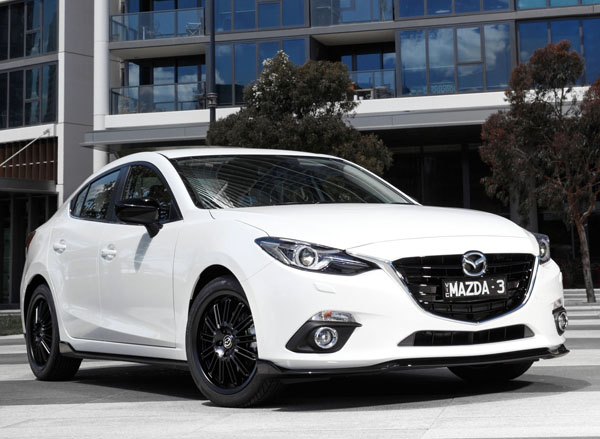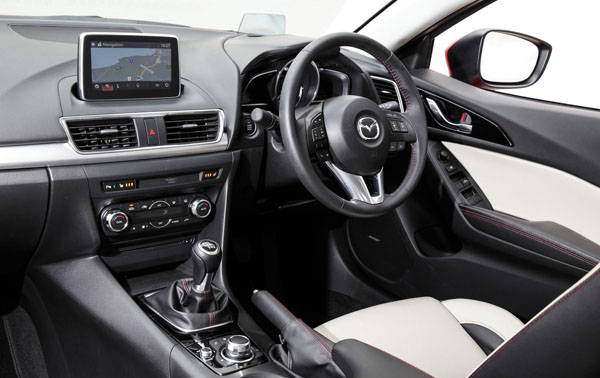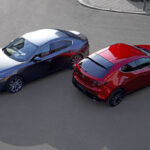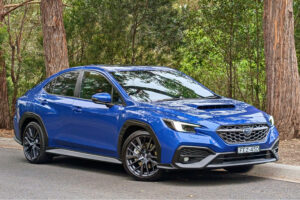
We recently reported on the sporty version of the new Mazda3, the SP25, which was covered by Derek Ogden. Now we have come down a notch to the Mazda3 with the 2.0-litre engine, not the big 2.5 unit fitted to the SP25.
Australians buy an amazing one tenth of all Mazda3s sold globally so it’s certainly worth reporting on the car again.
STYLING
The big-grille that’s such a feature of Mazda’s latest styling theme plays a major part in its sales success on every model on which it’s used. The all-new Mazda3 is the best iteration yet of this interesting style, at least in my humble opinion.

While it’s lower than its predecessors, the third generation Mazda3 is longer overall and in its wheelbase. The resulting shorter overhangs to give it a sportier look. The longer wheelbase makes for more interior space.
The sleek new body not only looks good, but also provides best-in-class coefficient of drag, at 0.28 for the hatch and 0.26 in the sedan. It’s not just the body’s shape, there is also an ‘active’ radiator grille shutter that opens just enough to provide maximum cooling no matter what the outside air temperature.
Body rigidity has been improved by 30 per cent compared to the superseded Mazda3, yet weight has been reduced by up to 70 kg. That’s thanks to the new computer-aided body design, and the use of high tensile-strength steels in critical safety areas.

ENGINES / TRANSMISSIONS
Mazda3 is sold with a choice between two engine choices in Australia: a SkyActiv-G 2.0-litre petrol engine and a new SkyActiv-G 2.5-litre petrol engine. The ‘G’ in the title stands for gasoline; a diesel option has just been announced, though these haven’t proven particularly popular in other Mazda passenger cars.
Transmissions are six-speed manual and six-speed automatic. Our test car had the manual and we found the shift light and easy in its operation.
SAFETY
Mazda3 offers Lane Departure Warning; Forward Obstruction Warning; Smart City Brake Support, if the driver fails to do so, this system do their braking for them. Not all items are installed in all models as standard, and some can be fitted as extra cost options. May we suggest talking to a Mazda dealer for details on which safety items you like in your car. Preferably all of them, in our professional opinion.
Should a crash still occur, the Mazda3 has six airbags; and whiplash-reducing front headrests.
DRIVING
The stretched body has created more rear seat legroom, with a reshaping of the front seatbacks giving added knee room. My six-foot frame was able to fit comfortably in the back with the front seat set in my normal driving position.
The base of the A-pillars have been repositioned rearwards to significantly improve the driver’s view, particularly when cornering on the twisty roads.
The large outside mirrors are set further rearwards than before to also improve forward vision. A downside is that I found myself having to move my head to use the driver’s side mirror, rather than relying on peripheral vision.
The instrument cluster in the topline Mazda3 models has a single large gauge for the tachometer. It’s flanked by a pair of smaller digital displays, one of them showing a digital speedometer. We’ve driven both instrument types in recent weeks and can’t say we have a strong preference either way.
We aren’t sure why the designers chose to hide the push-button starter behind the windscreen wiper stalk, perhaps they simply ran out of room on the dashboard.
We like the on-road feel of the new Mazda3. Its stronger body gives a feeling that’s almost European in its rigidity. Road grip is high and the feedback through the steering is nicely weighted.
The engine is responsive and has a sporty feeling that’s in keeping with the heritage of the company. Fuel consumption in daily driving is usually in the seven to nine litres per hundred kilometres range, on motorways and easy country roads this can come below six litres if you put your attention to getting the best from the car.
SUMMING UP
The previous Mazda3 was an impressive small-medium car that was loved by many Australian buyers, to the extent it managed to top the overall sales charts in 2011 and 2012. This all-new model has been improved in every area and seems likely to put up a big fight in the sales race against the new Toyota Corolla – the car that took top spot on the podium from Mazda3 in 2013.
As always, when the big boys battle it’s the buyer who is the winner. Call into a Mazda and/or Toyota dealer soon and see what’s in it for you.
AT A GLANCE
MODEL RANGE
Neo 2.0-litre petrol five-door hatch: $20,490 (manual), $22,490 (automatic)
Neo 2.0-litre petrol four-door sedan: $20,490 (manual), $22,490 (automatic)
Maxx 2.0-litre petrol five-door hatch: $22,990 (manual), $ 24,990 (automatic)
Maxx 2.0-litre petrol four-door sedan: $22,990 (manual), $ 24,990 (automatic)
Touring 2.0-litre petrol five-door hatch: $25,490 (manual), $27,490 (automatic)
Touring 2.0-litre petrol four-door sedan: $25,490 (manual), $27,490 (automatic)
SP25 2.5-litre petrol five-door hatch: $25,890 (manual), $27,890 (automatic)
SP25 2.5-litre petrol four-door sedan: $25,890 (manual), $27,890 (automatic)
SP25 GT 2.5-litre petrol five-door hatch: $30,590 (manual), $32,590 (automatic)
SP25 GT 2.5-litre petrol four-door sedan: $30,590 (manual), $32,590 (automatic)
SP25 Astina 2.5-litre petrol five-door hatch $36,190 (manual), $38,190 (automatic)
SP25 Astina 2.5-litre petrol four-door sedan: $36,190 (manual), $38,190 (automatic)
Note: These prices do not include government or dealer delivery charges. Contact your local Mazda dealer for drive-away prices.
FEATURES
ABS Brakes: Standard in all models
Automatic Transmission: Optional in all models
Cruise Control: Standard in all models
Dual Front Airbags: Standard in all models
Front Side Airbags: Standard in all models
Electronic Stability Program: Standard in all models
Rear Parking Sensors: Standard in all models
Reversing Camera: Not offered in Neo, standard in all other models
Auxiliary Audio Input: Standard in all models
Bluetooth: Standard in all models
Steering Wheel Mounted Controls: Standard in all models
SPECIFICATIONS (Mazda3 Maxx 2.0-litre petrol five-door hatch)
ENGINE:
Capacity: 1.998 litres
Configuration: Four cylinders in line
Head Design: DOHC, four valves per cylinder
Compression Ratio: 13.0:1
Bore/Stroke: 83.5 x 91.2 mm
Maximum Power: 114 kW @ 6000 rpm
Maximum Torque: 200 Nm @ 4100 rpm
DRIVELINE:
Driven Wheels: Front
Manual Transmission: Six-speed
Automatic Transmission: Six-speed
Final Drive Ratio: 4.105:1
DIMENSIONS, WEIGHT AND CAPACITIES:
Length: 4460 mm
Wheelbase: 2700 mm
Width: 1795 mm
Height: 1455 mm
Turning Circle: 10.6 metres
Kerb Mass: 1262 kg
Fuel Tank Capacity: 51 litres
Towing Ability: 1200kg with braked trailer
Boot Capacity: Not supplied
SUSPENSION AND BRAKES:
Front Suspension: MacPherson struts
Rear Suspension: Multi-link
Front Brakes: Ventilated Disc
Rear Brakes: Disc
FUEL CONSUMPTION:
Fuel Type: Petrol 91RON
Fuel Consumption – Combined Cycle (ADR 81/02): 5.8 L/100km
GREEN VEHICLE GUIDE RATINGS:
Greenhouse Rating: 8/10
Air Pollution Rating: 7.5/10
STANDARD WARRANTY:
Three years/unlimited km









